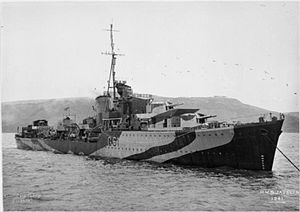 HMS Javelin in 1941
| |
| Class overview | |
|---|---|
| Operators | |
| Preceded by | Tribal class |
| Succeeded by | L and M class |
| Subclasses | J, K, N |
| Built | 1937–1941 |
| Planned | 25 |
| Completed | 24 |
| Cancelled | 1 |
| Lost | 13 |
| Scrapped | 11 |
| General characteristics (J and K classes as built) | |
| Type | Destroyer |
| Displacement | |
| Length | 356 ft 6 in (108.7 m) o/a |
| Beam | 35 ft 9 in (10.9 m) |
| Draught | 12 ft 6 in (3.8 m) (deep) |
| Installed power |
|
| Propulsion | 2 × shafts; 2 × geared steam turbines |
| Speed | 36 knots (67 km/h; 41 mph) |
| Range | 5,500 nmi (10,200 km; 6,300 mi) at 15 knots (28 km/h; 17 mph) |
| Complement | 183 (218 for flotilla leaders) |
| Sensors and processing systems | ASDIC |
| Armament |
|
| General characteristics (N class where different) | |
| Displacement |
|
| Armament |
|
The J, K and N class consisted of 24 destroyers built for the Royal Navy beginning in 1938. They were a return to a smaller vessel, with a heavier torpedo armament, after the Tribal class that emphasised guns over torpedoes. The ships were built in three flotillas or groups, each consisting of eight ships with names beginning with "J", "K" and "N". The flag superior of the pennant numbers changed from "F" to "G" in 1940.
The ships were modified throughout their wartime service, particularly their anti-aircraft (AA) guns; they were also fitted with radar.